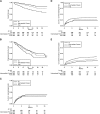Geriatric assessment predicts survival and toxicities in elderly myeloma patients: an International Myeloma Working Group report
- PMID: 25628469
- PMCID: PMC4375104
- DOI: 10.1182/blood-2014-12-615187
Geriatric assessment predicts survival and toxicities in elderly myeloma patients: an International Myeloma Working Group report
Erratum in
- Blood. 2016 Mar 3;127(9):1213
-
Erratum: Palumbo A, Bringhen S, Mateos M-V, et al. Geriatric assessment predicts survival and toxicities in elderly myeloma patients: an International Myeloma Working Group report. Blood. 2015;125(13):2068-2074.Blood. 2016 Mar 3;127(9):1213. doi: 10.1182/blood-2016-01-693390. Blood. 2016. PMID: 31265500 Free PMC article.
-
Erratum: Palumbo A, Bringhen S, Mateos M-V, et al. Geriatric assessment predicts survival and toxicities in elderly myeloma patients: an International Myeloma Working Group report. Blood. 2015;125(13):2068-2074.Blood. 2016 Aug 18;128(7):1020. doi: 10.1182/blood-2016-07-727081. Blood. 2016. PMID: 31265505 Free PMC article.
Abstract
We conducted a pooled analysis of 869 individual newly diagnosed elderly patient data from 3 prospective trials. At diagnosis, a geriatric assessment had been performed. An additive scoring system (range 0-5), based on age, comorbidities, and cognitive and physical conditions, was developed to identify 3 groups: fit (score = 0, 39%), intermediate fitness (score = 1, 31%), and frail (score ≥2, 30%). The 3-year overall survival was 84% in fit, 76% in intermediate-fitness (hazard ratio [HR], 1.61; P = .042), and 57% in frail (HR, 3.57; P < .001) patients. The cumulative incidence of grade ≥3 nonhematologic adverse events at 12 months was 22.2% in fit, 26.4% in intermediate-fitness (HR, 1.23; P = .217), and 34.0% in frail (HR, 1.74; P < .001) patients. The cumulative incidence of treatment discontinuation at 12 months was 16.5% in fit, 20.8% in intermediate-fitness (HR, 1.41; P = .052), and 31.2% in frail (HR, 2.21; P < .001) patients. Our frailty score predicts mortality and the risk of toxicity in elderly myeloma patients. The International Myeloma Working group proposes this score for the measurement of frailty in designing future clinical trials. These trials are registered at www.clinicaltrials.gov as #NCT01093136 (EMN01), #NCT01190787 (26866138MMY2069), and #NCT01346787 (IST-CAR-506).
Trial registration: ClinicalTrials.gov NCT01093196 NCT01190787 NCT01346787.
Figures
Comment in
-
New prognostic tools for myeloma.Blood. 2015 Mar 26;125(13):2014-5. doi: 10.1182/blood-2015-02-626408. Blood. 2015. PMID: 25814486
-
Gentle yet effective combination therapy with novel agents in elderly multiple myeloma patients.Br J Haematol. 2018 Jul;182(2):165-167. doi: 10.1111/bjh.15260. Epub 2018 May 6. Br J Haematol. 2018. PMID: 29732537 No abstract available.
References
-
- Palumbo A, Anderson K. Multiple myeloma. N Engl J Med. 2011;364(11):1046–1060. - PubMed
-
- Altekruse SF, Kosary CL, Krapcho M, et al., editors. SEER Cancer Statistics Review, 1975-2007. National Cancer Institute, Bethesda, MD. http://seer.cancer.gov/csr/1975_2007/. Accessed June 3, 2014.
-
- San Miguel JF, Schlag R, Khuageva NK, et al. VISTA Trial Investigators. Bortezomib plus melphalan and prednisone for initial treatment of multiple myeloma. N Engl J Med. 2008;359(9):906–917. - PubMed
-
- Fayers PM, Palumbo A, Hulin C, et al. Nordic Myeloma Study Group; Italian Multiple Myeloma Network; Turkish Myeloma Study Group; Hemato-Oncologie voor Volwassenen Nederland; Intergroupe Francophone du Myélome; European Myeloma Network. Thalidomide for previously untreated elderly patients with multiple myeloma: meta-analysis of 1685 individual patient data from 6 randomized clinical trials. Blood. 2011;118(5):1239–1247. - PubMed
-
- Palumbo A, Hajek R, Delforge M, et al. MM-015 Investigators. Continuous lenalidomide treatment for newly diagnosed multiple myeloma. N Engl J Med. 2012;366(19):1759–1769. - PubMed
MeSH terms
Substances
Associated data
LinkOut - more resources
Full Text Sources
Other Literature Sources
Medical


